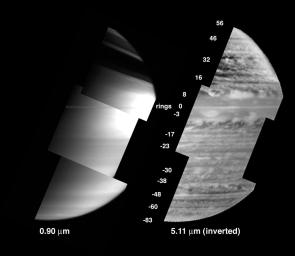New images provided by the visual infrared mapping spectrometer on the Cassini spacecraft reveal a diverse array of clouds in the depths of Saturn.
This new view on the right side shows clouds at an altitude where pressure is nearly 2-bar. (A bar is a unit of atmospheric pressure equivalent to Earth's sea-level atmospheric pressure.) These clouds are about 30 kilometers (19 miles) underneath the clouds usually observed on Saturn. This is distinctly different from the typical view of Saturn in reflected sunlight, shown on the left. The left view is characterized by broad expanses of clouds near the 1-bar level, such as the white cloud seen circling the equator, with little hint of the discrete cloud complexes lying underneath.
This new view was obtained at the 5-micron wavelength, using Saturn's own thermal radiation emanating from Saturn's interior as the light source instead of the Sun. Clouds at the 2-bar depth block this upwelling radiation to varying degrees, depending on the thickness of the cloud. At the 5-micron wavelength, the instrument sees such clouds as relatively dark areas in its view of Saturn. To render them visible as white clouds in the image shown on the right, the original view was photographically inverted. This technique enables clouds to be imaged across the globe, under both daytime and nighttime conditions. The images are also unaffected by shadowing from Saturn's immense ring system, unlike the left-hand image which has much of the northern hemisphere covered by ring shadow.
These images were acquired by Cassini's visual infrared mapping spectrometer on June 28, 2005, at a distance of 1.2 million kilometers (745,645 miles), and at a solar phase angle of 102 degrees. The image on the left was taken in reflected sunlight at 0.90 micron wavelength. The image on the right was taken in Saturn's thermal radiation at 5.1 micron wavelength, with the brightness inverted to reveal clouds as white and atmospheric clearings as dark.
The Cassini-Huygens mission is a cooperative project of NASA, the European Space Agency and the Italian Space Agency. The Jet Propulsion Laboratory, a division of the California Institute of Technology in Pasadena, manages the mission for NASA's Science Mission Directorate, Washington, D.C. The Cassini orbiter was designed, developed and assembled at JPL. The visual and infrared mapping spectrometer team is based at the University of Arizona.
For more information about the Cassini-Huygens mission http://saturn.jpl.nasa.gov. The visual and infrared mapping spectrometer team homepage is at http://wwwvims.lpl.arizona.edu.

 Planetary Data System
Planetary Data System












